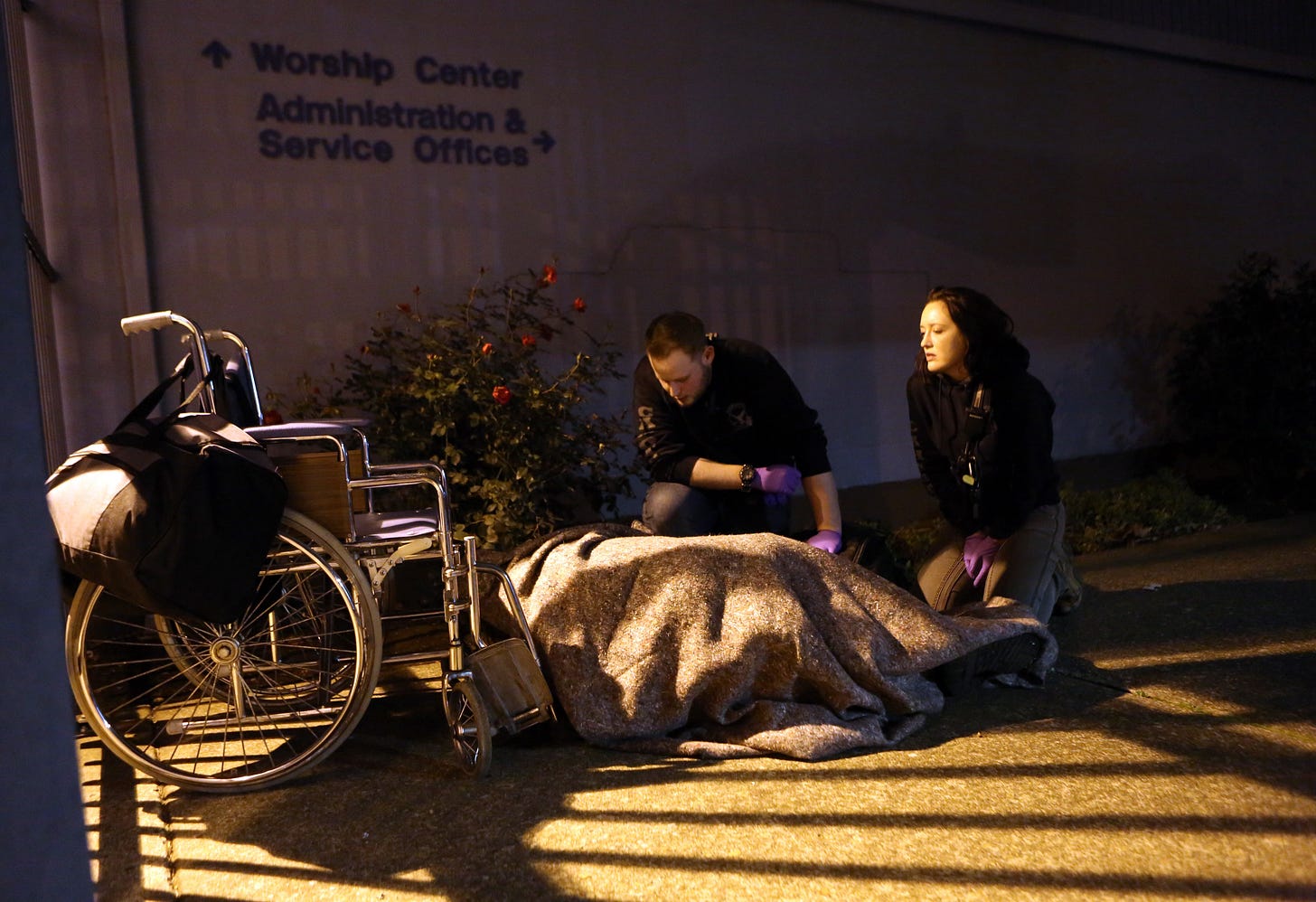The "SOME PEOPLE" Essays
Guns Down: The Compassionate First Responders Leveraging People in Need of Healthcare by Thomas Patterson | Edited by Kimberly J. Soenen April 24, 2025
(Photo by Thomas Patterson.)
Only a 911 call away, police have become the front line in dealing with the growing number of homeless and mentally ill people on American streets. The police are often ill-equipped to address distress calls and emergencies of this sort, which has resulted in a string of tragic shootings of nonviolent mentally ill people nationwide.
As a result, some cities and states are now considering following the lead of Eugene, Oregon, where a special team of mental health workers and emergency medical responders (EMTs) respond to such calls that might normally go directly to the police.
Ashley Barnhill Hubbard and Christian Hawks are two of those mental health workers caring for people in crisis in Eugene as part of the Crisis Assistance Helping Out on The Streets (CAHOOTS) program. On November 15, 2018, while on assignment for the Wall Street Journal, I rode with them in the CAHOOTS van responding to distress and emergency calls throughout the city.
No guns, no badges. Only knowledge, expertise, skills training and clean clothes.
The night’s first call led us to Alton Baker Park, where a woman lived deep in a thicket of vines and brambles along the Willamette River; her partner had been taken away to jail earlier in the day, and she feared for her safety alone in the dark. Over the course of two hours, Hubbard and Hawks gathered her earthly belongings into a shopping cart, heaved that shopping cart through the thicket, coaxed the distressed woman into the CAHOOTS van, and drove her to a women’s crisis shelter for healthcare and counseling services.
As a journalist, I’ve been on many ride-alongs with law enforcement and other first responders, so this wasn’t too out of the ordinary for me, but I was struck by the patience and empathy the CAHOOTS team demonstrated, the willingness to work hand-in-hand with the people they were serving. It seems to me this solution would be effective if implemented in many communities, and I’m surprised this nonviolent approach is not more widespread across the United States.
My hometown of Portland has a severe affordable housing shortage, so people with mental illness are far more likely to be out in the open. It’s a big problem we can’t ignore. A very large percentage of the people in the permanently-unhoused community suffer from some sort of mental illness.
I do feel “solutions journalism”—focusing on areas where we can make progress rather than only reporting intractable problems in society—has great value. Because mental illness can be so overwhelming, a new way of caring for those afflicted is hope-inducing.
After caring for the distressed woman, the team responded to a call about an incapacitated man outside a church in Eugene. Upon arrival, the CAHOOTS team woke him up, provided personal hygiene assistance, talked to him until he was calm, and accompanied him to a sobering station to get help.
Then we traveled to the next call of a long night.
ABOUT
Thomas Patterson is photojournalist, producer, writer, visual editor, archivist and creative consultant who likes to focus on people and communities in transition. Based in Portland, Oregon, he specializes in multimedia projects for editorial, corporate and nonprofit clients around the world. He currently creates and curates audiovisuals as the global archives lead and photo editor at Partners In Health, the social justice NGO that provides health access and research to some of the world's most vulnerable communities. Additionally, he studies Media and Medicine at Harvard Medical School's Institute of Global Health and Social Medicine, and works as an instructor and story coach with Momenta Workshops. He is the founder of OregonFocus.org — an online hub for the state’s photo community — and he is a member of the Portland Art Museum's Photography Council. For a decade he was on the photo staff of the Statesman Journal newspaper, earning a master's degree in Multimedia Journalism and completing a Graduate Teaching Fellowship at the University of Oregon School of Journalism and Communication. He worked for two years as the photo editor and content specialist at the international humanitarian organization Mercy Corps and for a year as a creative producer/director for Blue Chalk Media. He also served on Blue Earth Alliance's board of directors. His photography, writing and video work have received national and regional awards from the Associated Press, the Society of Professional Journalists, Gannett Company, the Columbia Scholastic Press Association and the Oregon Newspaper Publishers Association.
ADDITIONAL RESOURCES
Learn more about CAHOOTS




